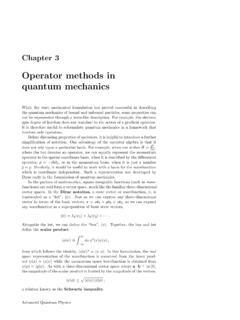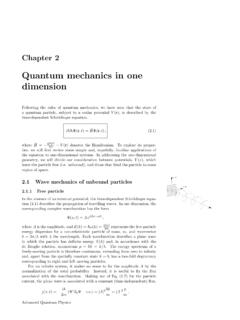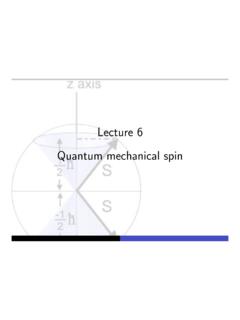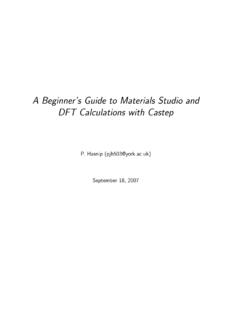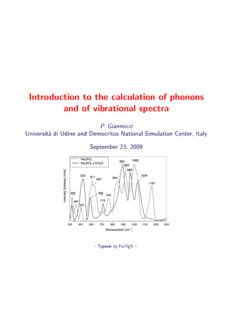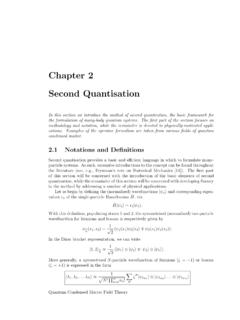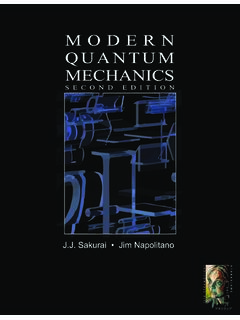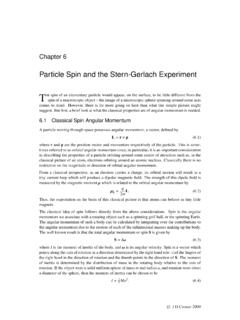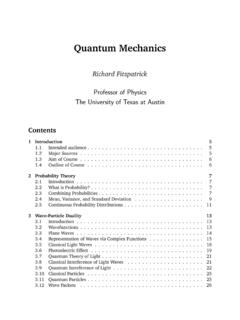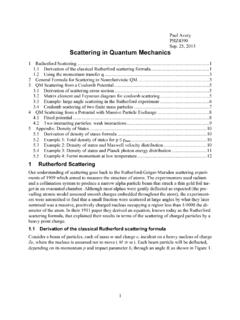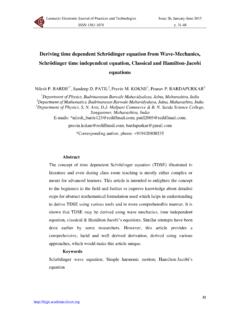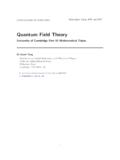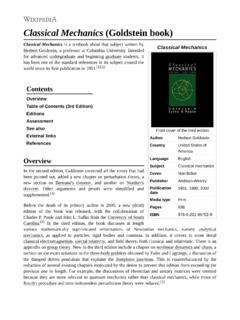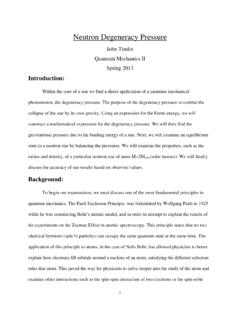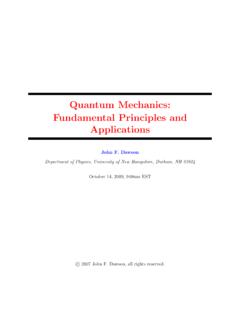Transcription of Quantum mechanics in one dimension - TCM Group
1 Chapter 2. Quantum mechanics in one dimension Following the rules of Quantum mechanics , we have seen that the state of a Quantum particle, subject to a scalar potential V (r), is described by the time-dependent Schro dinger equation, i! t (r, t) = H (r, t) , ( ). where H = !2m 2 2.. + V (r) denotes the Hamiltonian. To explore its proper- ties, we will first review some simple and, hopefully, familiar applications of the equation to one-dimensional systems. In addressing the one-dimensional geometry, we will divide our consideration between potentials, V (x), which leave the particle free ( unbound), and those that bind the particle to some region of space. Wave mechanics of unbound particles Free particle In the absence of an external potential, the time-dependent Schro dinger equa- tion ( ) describes the propagation of travelling waves. In one dimension , the corresponding complex wavefunction has the form (x, t) = A ei(kx t) , where A is the amplitude, and E(k) = !
2 (k) = !2m 2 2. k represents the free particle energy dispersion for a non- relativistic particle of mass, m, and wavevector k = 2 / with the wavelength. Each wavefunction describes a plane wave in which the particle has definite energy E(k) and, in accordance with the de Broglie relation, momentum p = !k = h/ . The energy spectrum of a freely-moving particle is therefore continuous, extending from zero to infinity and, apart from the spatially constant state k = 0, has a two-fold degeneracy corresponding to right and left moving particles. For an infinite system, it makes no sense to fix the amplitude A by the normalization of the total probability. Instead, it is useful to fix the flux associated with the wavefunction. Making use of Eq. ( ) for the particle current, the plane wave is associated with a constant (time-independent) flux, i! !k p j(x, t) = ( x ) = |A|2 = |A|2 . 2m m m Advanced Quantum Physics WAVE mechanics OF UNBOUND PARTICLES 11.
3 For a given value of the!flux j, the amplitude is given, up to an arbitrary constant phase, by A = mj/!k. To prepare a wave packet which is localized to a region of space, we must superpose components of different wave number. In an open system, this may be achieved using a Fourier expansion. For any function,1 (x), we have the Fourier decomposition,2. " . 1. (x) = (k) eikx dk , 2 . where the coefficients are defined by the inverse transform, " . 1. (k) = (x) e ikx dx . 2 . The normalization # of (k) #follows automatically from the normalization of . (x), (k) (k)dk = (x) (x)dx = 1, and both can represent probability amplitudes. Applied to a wavefunction, (x) can be understood as a wave packet made up of contributions involving definite momentum states, eikx , with amplitude set by the Fourier coefficient (k). The probability for a particle to be found in a region of width dx around some value of x is given by | (x)|2 dx.
4 Similarly, the probability for a particle to have wave number k in a region of width dk around some value of k is given by | (k)|2 dk. (Remember that p = !k so the momentum distribution is very closely related. Here, for economy of notation, we work with k.). The Fourier transform of a normalized Gaussian wave packet, (k) =. ( 2 )1/4 e (k k0 )2 , is also a Gaussian (exercise), . $ %1/4. 1 x2. (x) = eik0 x e 4 . 2 . From these representations, we can see that it is possible to represent a single particle, localized in real space as a superposition of plane wave states localized in Fourier space. But note that, while we have achieved our goal of finding localized wave packets, this has been at the expense of having some non-zero width in x and in k. For the Gaussian wave packet, we can straightforwardly obtain the width (as measured by the root mean square RMS) of the probability distribution.
5 X = (#(x #x$)2 $)1/2 (#x2 $ #x$2 $)1/2 = , and k = 14 . We can again see that, as we vary the width in k-space, the width in x-space varies to keep the following product constant, x k = 12 . If we translate from the wavevector into momentum p = !k, then p = ! k and ! p x = . 2. If we consider the width of the distribution as a measure of the uncertainty , we will prove in section ( ) that the Gaussian wave packet provides the minimum uncertainty. This result shows that we cannot know the position of a particle and its momentum at the same time. If we try to localize a particle to a very small region of space, its momentum becomes uncertain. If we try to 1. More precisely, we can make such an expansion providing we meet some rather weak conditions of smoothness and differentiability of (x) conditions met naturally by problems which derive from physical systems! 2. Here we will adopt an ecomony of notation using the same symbol to denote the wavefunction and its Fourier coefficients.
6 Their identity will be disclosed by their argument and context. Advanced Quantum Physics WAVE mechanics OF UNBOUND PARTICLES 12. make a particle with a definite momentum, its probability distribution spreads out over space. With this introduction, we now turn to consider the interaction of a par- ticle with a non-uniform potential background. For non-confining potentials, such systems fall into the class of scattering problems: For a beam of par- ticles incident on a non-uniform potential, what fraction of the particles are transmitted and what fraction are reflected? In the one-dimensional system, the classical counterpart of this problem is trivial: For particle energies which exceed the maximum potential, all particles are eventually transmitted, while for energies which are lower, all particles are reflected. In Quantum mechan- ics, the situation is richer: For a generic potential of finite extent and height, some particles are always reflected and some are always transmitted.
7 Later, in chapter 14, we will consider the general problem of scattering from a lo- calized potential in arbitrary dimension . But for now, we will focus on the one-dimensional system, where many of the key concepts can be formulated. Potential step As we have seen, for a time-independent potential, the wavefunction can be factorized as (x, t) = e iEt/! (x), where (x) is obtained from the stationary form of the Schro dinger equation, & 2 2 '. ! x + V (x) (x) = E (x) , 2m and E denotes the energy of the particle. As | (x, t)|2 represents a probablility density, it must be everywhere finite. As a result, we can deduce that the wavefunction, (x), is also finite. Moreover, since E and V (x) are presumed finite, so must be x2 (x). The latter condition implies that ' both (x) and x (x) must be continuous functions of x, even if V has a discontinuity. Consider then the influence of a potential step (see figure) on the prop- agation of a beam of particles.
8 Specifically, let us assume that a beam of particles with kinetic energy, E, moving from left to right are incident upon a potential step of height V0 at position x = 0. If the beam has unit amplitude, the reflected and transmitted (complex) amplitudes are set by r and t. The corresponding wavefunction is given by < (x) = eik< x + re ik< x x < 0. > (x) = teik> x x>0. ( (. where k< = 2mE. !2. and k> = 2m(E V !2. 0).. Applying the continuity conditions on and x at the step (x = 0), one obtains the relations 1 + r = t and ik< (1 r) = ik> t leading to the reflection and transmission amplitudes, k< k> 2k<. r= , t= . k< + k> k< + k>. The reflectivity, R, and transmittivity, T , are defined by the ratios, reflected flux transmitted flux R= , T = . incident flux incident flux Advanced Quantum Physics WAVE mechanics OF UNBOUND PARTICLES 13. With the incident, reflected, and transmitted fluxes given by |A|2 !))
9 Km< , |Ar|2 !km< , and |At|2 !km> respectively, one obtains ) ) ) ). ) k< k> )2 ) 2k< )2 k> 2 k> 4k< k>. R = )) ) = |r|2 , T = ) ). ) k< + k> ) k< = |t| k< = (k< + k> )2 . k< + k> ). From these results one can confirm that the total flux is, as expected, conserved in the scattering process, R + T = 1. ' Exercise. While E V0 remains positive, show that the beam is able to prop- agate across the potential step (see figure). Show that the fraction of the beam that is reflected depends on the relative height of the step while the phase depends on the sign of V0 . In particular, show that for V0 > 0, the reflected beam remains in phase with the incident beam, while for V0 < 0 it is reversed. Finally, when E V0 < 0, show that the beam is unable to propagate to the right (R = 1). Instead show that there is an evanescent decay of the wavefunction into the barrier region with a decay ! length set by 2 !
10 2 /2m(V0 E). If V0 , show that the system forms a standing wave pattern. Potential barrier Having dealt with the potential step, we now turn to consider the problem of a beam of particles incident upon a square potential barrier of height V0. (presumed positive for now) and width a. As mentioned above, this geometry is particularly important as it includes the simplest example of a scattering phenomenon in which a beam of particles is deflected by a local potential. Moreover, this one-dimensional geometry also provides a platform to explore a phenomenon peculiar to Quantum mechanics Quantum tunneling. For these reasons, we will treat this problem fully and with some care. Since the barrier is localized to a region of size a, the incident and(trans- mitted wavefunctions have the same functional form, eik1 x , where k1 = 2mE!2. , and differ only in their complex amplitude, after the encounter with the barrier, the transmitted wavefunction undergoes only a change of amplitude (some particles are reflected from the barrier, even when the energy of the incident beam, E, is in excess of V0 ) and a phase shift.)
